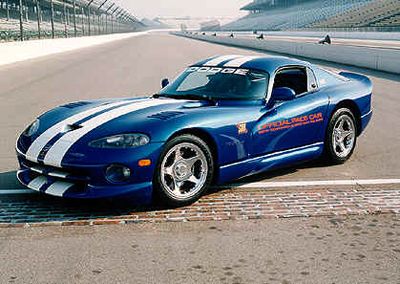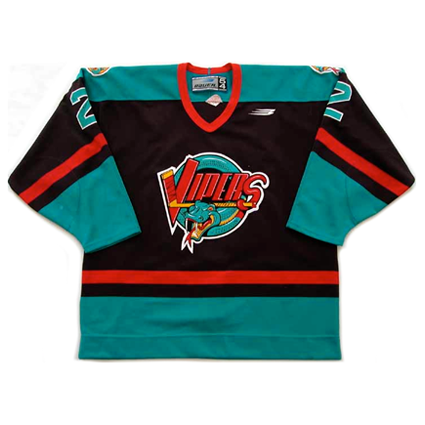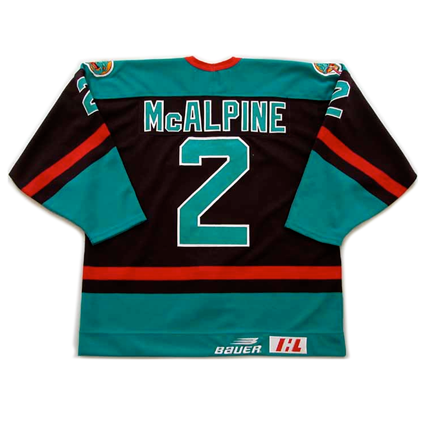Friday, July 2, 2010
1999-00 Detroit Vipers Chris McAlpine Jersey
July by the Numbers continues onto jersey #2.
Back in 1969, the Salt Lake Golden Eagles were founded and played in both the WHL and CHL prior to moving to the IHL in 1984. The team was sold in 1994 to Palace Sports and Entertainment, who owned the Detroit Pistons of the NBA, who relocated the club to the Detroit area to play in The Palace of Auburn Hills in time for the 1994-95 season.
A sponsorship agreement with the Chrysler Corporation led to the franchise being named the Detroit Vipers after Chrysler's Dodge Viper model.
The Vipers were an immediate hit at the box office, breaking the IHL attendance record in their first season with an average of 17,000 per game, something a number of NHL clubs would love to duplicate.
Led by Daniel Shank's 44 goals and Peter Ciavaglia's 81 points, the Vipers won the league's Northern Division, but were ousted in round 1 of the playoffs.
They again led the league in attendance in 1995-96 when Lonnie Loach led the team with 86 points. They defeated Indianapolis to advance to the second round of the playoffs before bowing out.
1996-97 saw the arrival of Russian Sergei Samsonov and IHL All-Star Stan Drulia to support Ciavaglia and Todd Simon, who led the team with 72 points each. Drulia followed with 71 and Samsonov was named Rookie of the Year following his 64 point campaign. The Vipers won the North Division with a league-best 122 points and entered the post season as favorites for the title.
Goaltender Rich Parent, who brought a 31-13-4 mark into the playoffs, guided the team past the Michigan K-Wings, the Quebec Rafales and the Cleveland Lumberjacks to reach the Turner Cup Finals against the Long Beach Ice Dogs. The Vipers won Game 1 at home 5-3, but lost Game 2 3-0. They took Games 3 and 4 in Long Beach, but the Ice Dogs stayed alive by winning Game 5 at home 2-1. Back on home ice for Game 6, Detroit clinched the championship with a 2-0 blanking of the Ice Dogs, led by Ciavaglia's 33 playoff points in 21 games.
1997-98 will be remembered for a one off appearance by the nearly 70 year old Gordie Howe, which made him the only player to appear in a professional game in six different decades.
The Vipers again won their division and were led by Dan Kesa and Steve Walker in points with 77 and 76 respectively. Jeff Reese took the bulk of the goaltending duties and in 46 games went 27-9-8. The team returned to the finals again, but despite taking a 3 games to 2 lead, lost the final two games to the Chicago Wolves.
Their success on the ice continued in 1998-99 when they scored 100 points in the standings for the fifth straight season, the first professional team to do so in their first five seasons. Drulia led the team with 75 points. The playoffs saw them reach the conference finals before losing in overtime of Game 7.
The Palace Sports and Entertainment organization purchased the Tampa Bay Lightning of the NHL in 1999, which had a tremendous adverse effect on the Vipers, where were now the Lightning's top minor league affiliate. The struggling Lightning called up many of the Vipers better players throughout the season, plummeting the once strong and stable Vipers to the depths of the league, where they finished last with 52 points, 26 less than the second-worst team. Walker's 46 points led the club, his low total a reflection of the state of the franchise.
2000-01 was a repeat of the previous season, as Detroit again managed only 52 points in the standings, a distant last in the league. Martin Cibak was the leading scorer with just 38 points.
The Vipers were now last in league attendance and the IHL was in deep trouble as a league as well. Only four teams had NHL affiliations, travel costs had risen as the league expanded and finally the league folded after the 2000-01 season after 56 years of operation. Six of the 11 remaining IHL clubs survived by joining the AHL, but the Vipers were not included as one of the six and ceased operations on June 4, 2001 when the IHL ended for good.
The story of the Detroit Vipers is a melancholy one, flying high in attendance and in the standings, setting records for success on both fronts and winning a championship, followed by a complete collapse both on the ice and at the box office in two short seasons, flaming out like a shooting star.
Today's featured jersey is a 1999-00 Detroit Vipers Chris McAlpine jersey. While the Vipers were a success on the ice for the majority of their existence, their jerseys were not.
Unfortunately the team relocated to Detroit at a time when the color palette of sports was changing due to the commerical success of the San Jose Sharks teal jerseys, first introduced in 1991.
The Vipers brash color scheme included the trendy 90's colors of dark eggplant and aqua for their jerseys, with garish red striping. Add in the overly complicated Vipers logo and you are left with one seriously ugly eyesore of a jersey that was neither classy, timeless or attractive in any way. And you should see the font they originally used in 1994-95 for the numbers. Terrible! Fortunately Gordie Howe wore the home white version of the jersey, which was somewhat less appalling.
Today's video begins with a look at the madness and mayhem of minor league hockey. Perhaps all the hard hits and fights were a result being angry about having to wear those horrible colored jerseys.
This next video was produced by the team and given to season ticket holders which celebrates their Turner Cup Championship in 1997.
Labels:
Detroit Vipers,
IHL
Subscribe to:
Post Comments (Atom)















I went to four or five Vipers' games during their first season. It was a good time and was good hockey. Never knew the name came from a Chrysler sponsorship. Learn something new everyday, and a lot of times it comes from this blog.
ReplyDeleteIt's sad how the Vipers flamed out like a comet once they became a minor league affiliate of the Lightning. Losing their rivalry with the Chicago Wolves was a lost opportunity for the AHL.
ReplyDeleteNice review. But I have a curious thought. On the 1994-95 jersey of the Detroit Vipers, which font on the numbers was it?
ReplyDeleteSorry, we have no idea what that font was, but know it should never be used again, anywhere at any time.
ReplyDelete